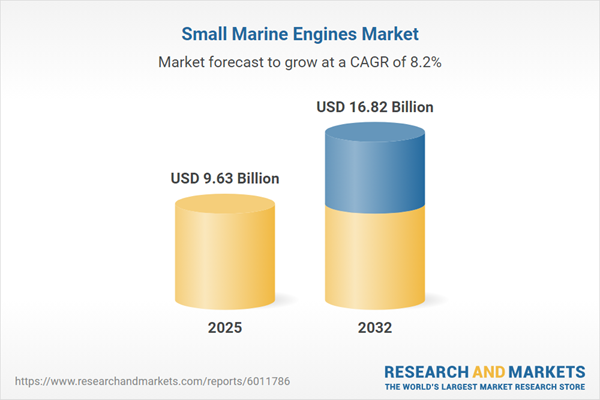Speak directly to the analyst to clarify any post sales queries you may have.
Senior leaders in the small marine engines market face complex challenges driven by evolving regulations, technological transformation, and rising operational demands. Staying ahead requires actionable market intelligence and a clear view of shifting sector priorities.
Market Snapshot: Small Marine Engines Market
The small marine engines market is demonstrating sustained growth and resilience, estimated at USD 8.94 billion in 2024 with expected expansion to USD 9.63 billion by 2025. The market is further projected to reach USD 16.82 billion by 2032, reflecting a compound annual growth rate of 8.21%. This trajectory stems from a blend of factors, including increased activity in commercial shipping, a rise in global recreational boating, and expanding defense sector requirements. Purchasing decisions consistently target reliable performance and regulatory compliance as sector participants address environmental standards, fleet modernization, and specific operational needs. Product innovation maintains a focus on durability, efficiency, and sustainability to serve varied marine segments.
Scope & Segmentation
- Engine Types: Inboard, outboard, and sterndrive engines meet demands across cargo, enforcement, leisure, and specialized vessels, supporting adaptability in deployment.
- Horsepower Ranges: Engine offerings range from low-output models for recreational applications to high-power solutions equipped for commercial, emergency, and military fleets.
- Fuel Types: Diesel and gasoline engines remain prevalent, while interest in electric and hybrid propulsion is increasing to support strict compliance and sustainability.
- Cooling Systems: Both air-cooled and water-cooled variants extend engine service life and efficiency, supporting diverse operating environments and reducing long-term maintenance needs.
- Applications: Market solutions address commercial, defense, leisure, and specialized fleets, each with tailored reliability and compliance requirements.
- Distribution Channels: Engines are procured via dealerships, direct-manufacturer sales, and digital channels, with timely service and parts access emerging as key priorities.
- Sales Channels: Customers acquire engines for new builds (OEM) and retrofit existing vessels through robust aftermarket pathways for continued modernization.
- Geographical Regions: The market is influenced by regulatory differences and infrastructure investment across the Americas, Europe, Middle East and Africa, and Asia-Pacific, each experiencing specific operational drivers.
- Companies Covered: Key industry participants include Brunswick Corporation, Yamaha Motor Co., Honda Motor Co., Suzuki Motor Corporation, Tohatsu Corporation, Volvo Group, Parsun Power Machine Co., Selva Marine S.p.A., Nanni Industries, Changzhou Weiya Marine Engine, Mahindra Powerol, Hyundai SeasAll, FPT Industrial, Mitsubishi Heavy Industries-VST, MAN Energy Solutions SE, Kohler Co., Cummins Inc., and YANMAR Holdings Co., Ltd.
Key Takeaways for Senior Decision-Makers
- Regulatory compliance guides technology evolution, shaping development pipelines and influencing supplier relationships sector-wide.
- Adoption of hybrid and electric propulsion improves operational flexibility, enables sustainable transitions, and supports alignment with new performance expectations.
- Integrated digital technologies enhance predictive maintenance, reduce unplanned downtime, and optimize overall fleet management.
- Strengthened regional supply chains and service operations improve delivery capability, especially where marine infrastructure is rapidly developing.
- Utilizing digital aftermarket tools supports asset tracking and ensures fleets receive proactive support throughout the engine lifecycle.
- Adaptive development practices and close supplier partnerships foster rapid response to changing market or regulatory pressures, supporting organizational resilience.
Tariff Impact: Navigating New US Tariffs in 2025
The introduction of US tariffs is prompting the small marine engines sector to adjust by moving toward nearshoring, creating regionally focused supply networks, and embracing modular assembly practices. These efforts enable manufacturers and stakeholders to enhance business continuity, accelerate product innovation, and build resilience as global trade conditions shift. Increased local investment in research and development is strengthening the sector’s ability to respond to future challenges and maintain steady operations.
Methodology & Data Sources
This report uses a combination of executive-level interviews, expert regulatory analysis, curated maritime publications, proprietary shipping datasets, and direct procurement feedback. This approach yields targeted and reliable insights for all small marine engine stakeholders.
Why This Report Matters
- Enables senior decision-makers to proactively respond to technology shifts, regulatory changes, and operational challenges through targeted insights into the small marine engines market.
- Supports effective segmentation and benchmarking for risk mitigation, sourcing strategies, and long-range planning across global fleets.
- Delivers actionable context, empowering leadership teams to align initiatives amid ongoing industry transformation.
Conclusion
Sustained competitiveness in the small marine engines market derives from informed leadership, agile response to sector developments, and strong organizational strategies attuned to evolving market realities.
Additional Product Information:
- Purchase of this report includes 1 year online access with quarterly updates.
- This report can be updated on request. Please contact our Customer Experience team using the Ask a Question widget on our website.
Table of Contents
3. Executive Summary
4. Market Overview
7. Cumulative Impact of Artificial Intelligence 2025
Companies Mentioned
The companies profiled in this Small Marine Engines market report include:- Brunswick Corporation
- Yamaha Motor Co., Ltd.
- Honda Motor Co., Ltd.
- Suzuki Motor Corporation
- Tohatsu Corporation
- Volvo Group
- Parsun Power Machine Co., Ltd.
- Selva Marine S.p.A.
- Nanni Industries S.A.S.
- Changzhou Weiya Marine Engine Co., Ltd.
- Mahindra Powerol
- Hyundai SeasAll Co., Ltd.
- FPT Industrial
- Mitsubishi Heavy Industries-VST Diesel Engines
- MAN Energy Solutions SE
- Kohler Co.
- Cummins Inc.
- Tohatsu Corporation
- YANMAR Holdings Co., Ltd.
Table Information
| Report Attribute | Details |
|---|---|
| No. of Pages | 190 |
| Published | November 2025 |
| Forecast Period | 2025 - 2032 |
| Estimated Market Value ( USD | $ 9.63 Billion |
| Forecasted Market Value ( USD | $ 16.82 Billion |
| Compound Annual Growth Rate | 8.2% |
| Regions Covered | Global |
| No. of Companies Mentioned | 20 |









